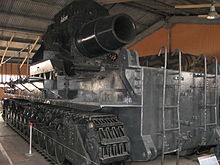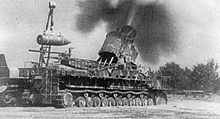Mortar Karl
| Mortar Karl | |
|---|---|
| General Information | |
| Military designation: | Device 040/041 |
| Manufacturer country: | German Empire |
| Developer / Manufacturer: | Rheinmetall , Düsseldorf |
| Production time: | 1940 to 1942 |
| Number of pieces: | 7th |
| Model variants: | 2 |
| Technical specifications | |
| Pipe length: | 5.07 m |
| Caliber : |
60 cm / 54 cm |
| Caliber length : | L / 8.45 / L / 11.5 |
| Cadence : | 0.1 rounds / min |
| Elevation range: | 0 ° to +70 degrees |
| Side straightening area: | 4 ° |
The "Karl" mortar , the 040/041 or Karl device was an oversized mortar that was used by the Wehrmacht in World War II .
history


The planning of the 60 cm mortar (device 040) began as early as 1937. They were designed for use against heavy fortifications such as the Maginot Line . The gun weighed about 124 tons and could reach about 10 km / h on its full -track self-propelled gun . The self-propelled gun was available in two versions: the first had eight rollers and eight support rollers, while the second had eleven rollers and six support rollers. The chains in both versions were 50 cm wide and had a contact area of 7 m². The track width was 2.65 m and the ground clearance 35 cm. The device developed a high ground pressure and could therefore only be used on solid ground. Six units of the 040 series and one of the modified 041 series were built. The seven guns were given the following names: I = " Adam " (later " Baldur "), II = " Eva " (later " Wotan "), III = " Odin ", IV = " Thor ", V = " Loki ", VI = " Ziu " and VII = " Fenrir ".
In February 1941, a higher firing range of the mortar was required, which was implemented by reducing the caliber to 54 cm (device 041). If the 60 cm pipes were used up, they should be replaced by the smaller version. Six of these new pipes were ordered and were available from May 31, 1944. The seventh mortar, which had already been delivered from the factory with the 54 cm barrel from the 041 series, was never used.
The Daimler-Benz MB 503A gasoline engine was intended as the drive motor . However, after test runs, the MB 507C diesel engine was recommended. Both engines were procured, five of which were gasoline and five were diesel engines.
For transport, the mortar could be broken down into three loads and using Culemeyer - road scooters are transported. There was a special carrying chute car for transport by rail . Each mortar included two ammunition tractors ( Panzer IV chassis) each with a 2.5 t crane.
The operation consisted of 16 gunners . The pipe had to be placed horizontally for loading; the maximum tube elevation was 70 °. The field of elevation was 2.5 ° to the left and right, so that the entire gun had to be roughly aimed at the target. For firing, the vehicle hull had to be lowered to the floor by hydraulics in order to better distribute the enormous forces during the shot.
This gun was ready to fire in ten minutes and fired six to twelve shells an hour. A light and a heavy concrete grenade with a weight of 1700 kg (of which 280 kg of explosives) and 2180 kg (of which 348 kg of explosives) as well as an explosive grenade of 1250 kg (of which 460 kg of explosives) were used, depending on the desired range and Effect were selected. One to nine propellant charges (32 to 36 kg of gunpowder each) were inserted as propellant charges. The more than five meter long barrel shot at a firing angle of 50 to 60 degrees and, depending on the shell, about 4.3 km to 6.5 km (the 54 cm version 041, which was later converted, had a range of up to 10.5 km ). A shell could penetrate 2.50 m of concrete or 35 cm of armor steel. Tests had been carried out on the Rügenwalde-Bad shooting range in Western Pomerania , among other places .
Like all weapons of this type with heavy and slow-flying projectiles (192–179 m / s, flight time up to 49 seconds), the mortar has a high degree of dispersion. Its effect on the bombarded fortress crews consisted more of a demoralizing effect than of direct impact, as it could destroy supposedly safe fortifications. It was first used in 1941 near Brest-Litovsk and in 1942 during the conquest of Sevastopol , when two mortars, “Thor” and “Odin”, fired at the fortifications there. Another use took place in 1944 during the Warsaw Uprising .
- Shelling of the Prudential Insurance Tower during the Warsaw Uprising
At a briefing on August 14, 1944, Hitler inquired about the whereabouts of the mortar, as he wanted to send it to General Dietrich von Choltitz, who had been appointed commandant of Greater Paris shortly before . After a copy could be found a little later in a depot near Berlin, it was set off for Paris. The mortar reached Soissons , around 92 km northeast of Paris, within a week , but was no longer used. Von Choltitz capitulated on August 25, 1944 .
On March 8, 1945, the mortar was used on the Ludendorff Bridge , which was captured by the US armed forces . The Karl mortar (caliber 540 mm) that was brought in, however, missed its target and had to stop working after a short time due to technical problems.
At the end of the war five of the guns were blown up by their crews; the other two were captured by Allied troops. The VI “Ziu” gun is (as of 2017) in the Red Army Tank Museum in Kubinka near Moscow.
Technical specifications
- Designation of the vehicle: Device 040/041
- Type: self-propelled gun
- Manufacturer: Rheinmetall
- Year of construction: 1940 to 1944
- Engine: Daimler-Benz MB 503A (petrol) / MB 507C (diesel)
- Number of cylinders, arrangement: 12 cylinders, V-arrangement
- Displacement: 44,500 cm³ (MB 503A)
- Speed: 1850 / min (MB 503A)
- Maximum output: 426 kW (580 hp) MB 503A
- Top speed: 10 km / h
- Transmission: 4 gears
- Ground clearance: 350 mm
- Track width: 2650 mm
- Chain width: 500 mm
- Chain contact area: 7 m²
- Combat weight: 124 t (device 040) / 126 t (device 041)
- Ground pressure : 1.77 kg / cm²
- Fuel supply: 1200 l
- Material thickness: up to 10 mm
- Armament: 60 cm mortar L 8.45 (device 040) / 54 cm mortar L / 13 (device 041)
- Ammunition: HE grenade / concrete grenade
- Maximum firing range high explosive grenade: 6.6 km
- Maximum range of concrete grenades: 4.3 km
- Production numbers: 7 pieces
literature
- Walter J. Spielberger: Special armored vehicles of the German army. Motorbuch Verlag, Stuttgart 2012, ISBN 978-3-613-03487-7 .
See also
Web links
60 cm mortar "Karl" device 040
- 60 cm mortar device 040 "Thor" on waffenhq.de
Footnotes
- ↑ Der Spiegel 36/1964: Karl did not arrive









